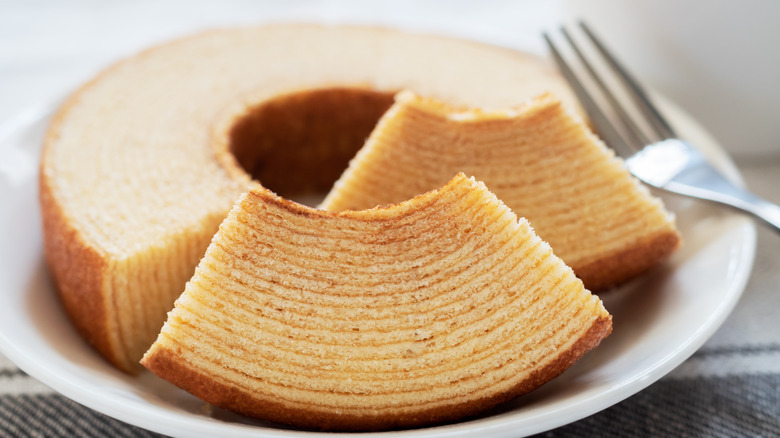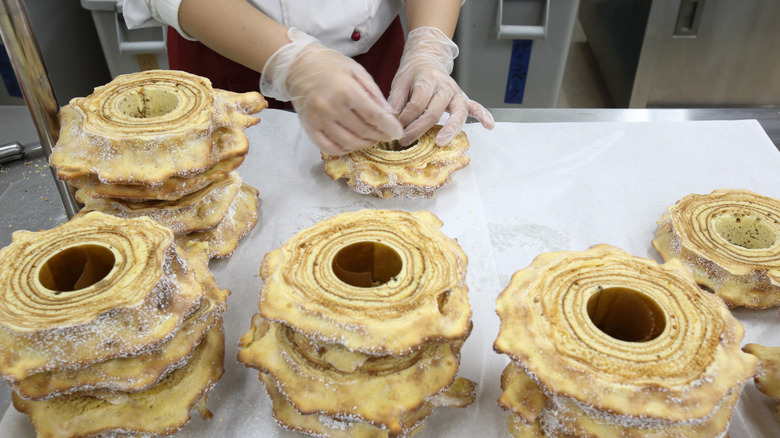Baumkuchen Is The German Cake That Takes Three Hours To Make
Cooking and baking can be challenging. Sometimes that challenge is a part of the fun. Practicing and improving the craft of making fresh pasta, for example, can be a rewarding activity or tradition. Certain recipes, though, are either just too complex, time-consuming, or specialized to make for yourself on a whim. One such recipe hailing from Germany is the Baumkuchen or "tree cake."
This little-known German dessert is a delicious specialty you should never make at home. The traditional baumkuchen is a three-foot-tall cake that is baked on a rotating spit oven. It consists of multiple paper-thin layers of cake that grow outward and resemble the inner rings of a tree when cut into sections. This is done by applying the simple batter made with a base of butter, flour, and eggs onto the spit, letting it bake and caramelize, applying another layer, letting it bake, and continuing that process for as long as three hours.
Not only does this specialty cake require a specialized oven to obtain the signature rings, but the sheer time required to create the unique dessert will easily disqualify most home bakers. Understandably so, since it even scares off plenty of professional bakers.
A tradition of tree cakes
Baumkuchen might be considered a quintessentially German creation, but it is actually part of a European tradition of tree cakes. Austria, Lithuania, Poland, and Sweden all have their own take on tree cakes.
Some take the name much further than simply recreating the rings of a tree. In Eastern European countries, the batter is also poured in a way that it spikes out from the base "trunk" of the cake. These spikes resemble the branches of a tree and build on the baked good's identity.
Tree cakes have also been exported and have become a popular tradition in Japan. According to JAPAN Forward, the cake-making tradition came to the island nation by way of a German prisoner of war who would settle down in Japan after being freed. He started several cafes and popularized the tradition of making Baumkuchen in the period between the first and second world wars. The cake is still popular today as a symbolic food that represents long life, happiness, and luck to many in the country.
Where to find baumkuchen
Why is Baumkuchen worth all of this trouble? While there is the obvious aesthetic reason, it is also a dessert that is said to be deceptively delicious. It only consists of a simple cake batter, but the time spent baking each layer also creates caramelization on each subsequent ring. This apparently gives it a light and simple flavor with a depth that helps it stand apart.
It can also be coated in a variety of glazes and icings. Some bakers use a traditional apricot sugar glaze as a base coat before applying secondary layers of dark or milk chocolate to provide more flavor to the cake and trap moisture.
You can still find a few shops in Germany that continue to make the traditional baumkuchen. However, if you live anywhere else, your best bet for finding this cake is to order it online; you'll find vendors selling imported German and Japanese preparations of the cake. You can also seek out local offerings from bakeries like Lutz in Chicago and Minamoto Kitchoan, a chain of shops specializing in Japanese wagashi sweets with locations in New York City, San Francisco, Honolulu, Los Angeles, and New Jersey.


